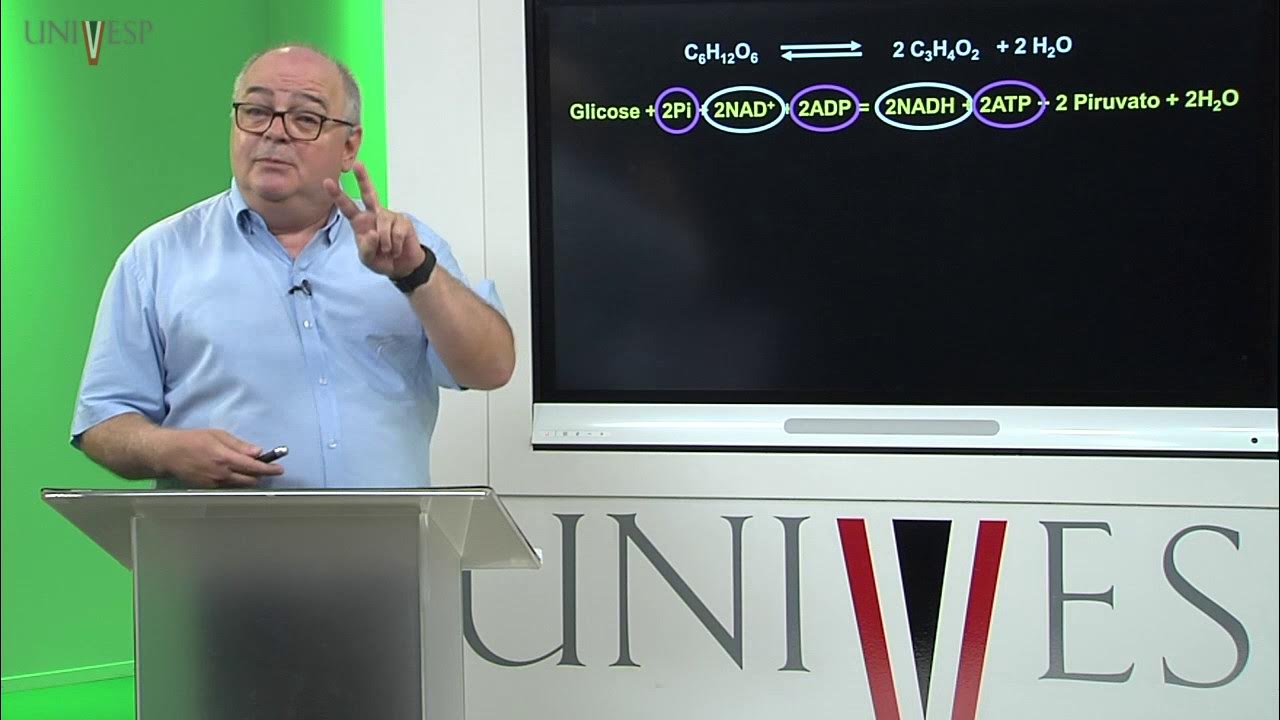AP Bio - Cellular Respiration - Part 2
Summary
TLDRThis video explains the process of cellular respiration, focusing on glycolysis, fermentation, and the role of ATP in energy production. It covers the differences between aerobic, anaerobic, and facultative organisms, highlighting how yeast can switch between fermentation and aerobic respiration depending on oxygen availability. The video also introduces feedback inhibition, which regulates ATP production to maintain energy balance in cells. Through examples like wine fermentation, it illustrates how cellular respiration adapts to environmental conditions to ensure efficient energy use without waste.
Takeaways
- 😀 Cellular respiration is the process by which cells extract energy from glucose to produce ATP, the main energy carrier in cells.
- 😀 Glycolysis is the first step of cellular respiration, occurring in the cytoplasm, where glucose is broken down into pyruvate, producing a small amount of ATP and NADH.
- 😀 If oxygen is present, pyruvate enters the mitochondria for aerobic respiration, which is much more efficient than anaerobic processes.
- 😀 In the absence of oxygen, cells can undergo anaerobic processes like fermentation, either alcohol fermentation (in yeast) or lactic acid fermentation (in muscles).
- 😀 During alcohol fermentation, NADH is oxidized to NAD+, allowing glycolysis to continue in the absence of oxygen, producing ethanol and ATP.
- 😀 Lactic acid fermentation, similarly, regenerates NAD+ and produces lactate instead of ethanol as a byproduct.
- 😀 Obligate anaerobes can only survive in environments without oxygen, while obligate aerobes require oxygen to survive.
- 😀 Facultative organisms, like yeast, can adapt to either aerobic or anaerobic respiration based on oxygen availability, preferring aerobic respiration when oxygen is present.
- 😀 Feedback inhibition helps regulate ATP production, where excess ATP inhibits early enzymes in the process to prevent overproduction of ATP.
- 😀 ATP levels control the rate of cellular respiration; when ATP is abundant, respiration slows down, but when ATP is scarce, the process speeds up to replenish it.
Q & A
What is glycolysis and why is it important?
-Glycolysis is the process by which glucose is broken down to produce ATP, the primary energy carrier in cells. It is important because it is the first step in cellular respiration, generating energy even in the absence of oxygen.
What happens during fermentation in the absence of oxygen?
-During fermentation, cells regenerate NAD+ by converting pyruvate into either ethanol or lactate. This process allows glycolysis to continue producing ATP, even without oxygen.
What is the difference between obligate aerobes and obligate anaerobes?
-Obligate aerobes require oxygen to survive, while obligate anaerobes cannot tolerate oxygen and will die in its presence.
How do facultative anaerobes adapt to different oxygen conditions?
-Facultative anaerobes can switch between aerobic respiration (when oxygen is available) and anaerobic processes like fermentation (when oxygen is absent), depending on the environment.
What is feedback inhibition in cellular respiration?
-Feedback inhibition is a regulatory mechanism where the accumulation of a product, like ATP, slows down the enzymes involved in a process, preventing overproduction. It helps maintain balance in cellular energy production.
How does the body regulate ATP levels during cellular respiration?
-When ATP levels are high, enzymes in the respiration process are inhibited, slowing down ATP production. Conversely, when ATP levels are low, the process speeds up to generate more ATP.
What is the role of NAD+ in glycolysis and fermentation?
-NAD+ is essential for glycolysis because it helps oxidize glucose. In fermentation, NAD+ is regenerated, allowing glycolysis to continue producing ATP in the absence of oxygen.
How does alcoholic fermentation work in yeast?
-In the absence of oxygen, yeast undergo alcoholic fermentation, where pyruvate is converted into ethanol (alcohol) and carbon dioxide, regenerating NAD+ so that glycolysis can continue and produce ATP.
Why is the process of fermentation important for organisms like yeast?
-Fermentation allows organisms like yeast to generate ATP when oxygen is not available, ensuring survival in anaerobic conditions, such as when oxygen is depleted in sealed containers.
What are the byproducts of lactic acid fermentation in humans?
-The byproducts of lactic acid fermentation in humans are lactate (lactic acid) and NAD+. This process occurs in muscle cells when oxygen is scarce, allowing continued ATP production in anaerobic conditions.
Outlines

This section is available to paid users only. Please upgrade to access this part.
Upgrade NowMindmap

This section is available to paid users only. Please upgrade to access this part.
Upgrade NowKeywords

This section is available to paid users only. Please upgrade to access this part.
Upgrade NowHighlights

This section is available to paid users only. Please upgrade to access this part.
Upgrade NowTranscripts

This section is available to paid users only. Please upgrade to access this part.
Upgrade Now5.0 / 5 (0 votes)





